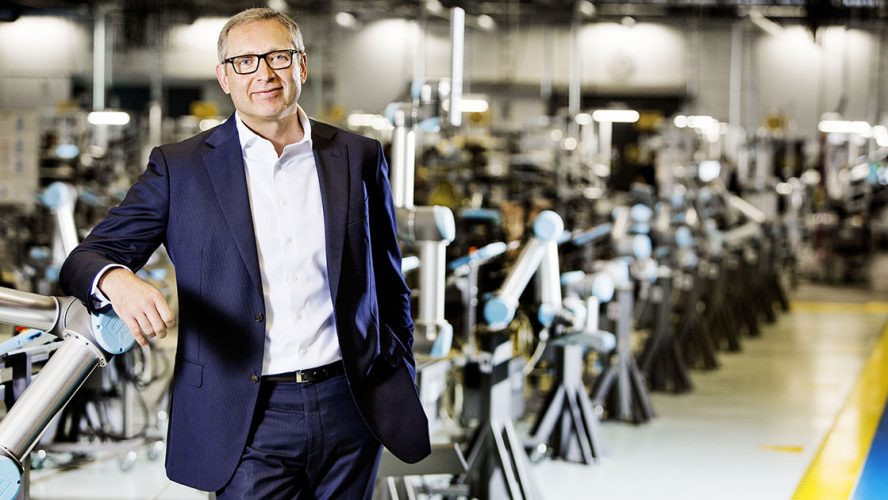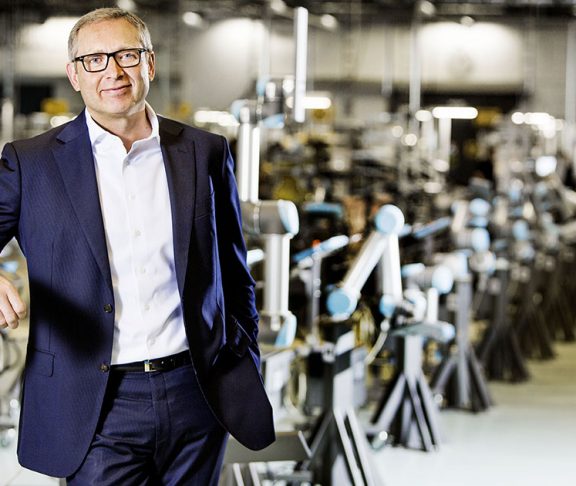Jürgen Von Hollen, the president of Universal Robots, discussed the dramatic growth in the implementation of collaborative robots in industrial applications.
How is your technology a cost-effective solution for industrial operations?
When people think about robotics in industrial automation, they tend to think about large, expensive machines that are permanently installed behind safety guarding to protect human workers as the robot performs the same task millions of times. But industry is changing. Many manufacturers are looking for ways they can deliver highly specialized products quickly, accurately and cost-effectively, even at lower volumes. Today even small manufacturers sell their products on a global scale, and they need the advantages of automation to help them compete. That’s why collaborative robot technology has had such a dramatic impact.
Cobots are flexible, lightweight robot arms that can be installed almost anywhere and are easy to program, so companies don’t need expensive robot programmers on staff. With low up-front costs and return on investment in well under a year, cobots can be implemented by smaller manufacturers with limited space and resources, as well as by large operations for specialized processes.
What effect does your automation and robotics have on workload efficiency?
Workload efficiency requires agility. It’s time-consuming and expensive for companies to find, train, retrain and retain workers for dirty, dull and dangerous jobs (the “3Ds”). It’s hard to keep workers focused on highly repetitive tasks over long shifts, so product quality and consistency can suffer, and workers are susceptible to injuries. But cobots can work all year, around the clock if needed. They don’t get tired, they don’t require breaks and they don’t call in sick or quit unexpectedly. They can be easily moved to different processes, with saved programs so changeovers are highly efficient, and they’re low-maintenance and reliable.
Because cobots are designed to work beside human workers, manufacturers can apply both for the greatest efficiencies. The robot is ideal for repetitive processes that require high accuracy and consistency, while human workers manage processes that are changeable or that demand human dexterity or problem-solving.
Does the integration of automation improve the accuracy of warehouse tasks?
Warehousing is an exciting area for automation. Robots have always been very good at repeatability and reliability — doing the same thing over and over, exactly the same way. With advances in machine learning software, vision systems and new gripper technology, however, robots can be applied to even highly changeable warehouse tasks. Today’s robots can “learn” in much the same way that a child can be taught how to pick up a wide range of items that are different sizes, shapes and weights — even those that are jumbled together in a bin. These capabilities are dramatically expanding the advantages of robots in warehouses.
How can implementing automation alongside employees improve safety?
Every robotic application needs a risk assessment to make sure that the complete application is safe for human workers. That includes the end-of-arm tooling and the work piece itself, as well as elements such as the robot’s design and its movements and speed. Cobots are designed with built-in force-limiting capabilities so that even if a person steps in front of the robot arm, it won’t cause injury. Other safety features allow the robot arm to slow or stop if it senses a person in its workspace. In addition to those safety features, however, cobots can improve worker safety simply by taking over repetitive or dangerous tasks that are known for causing injuries, such as lifting or twisting objects, working with hazardous materials or operating heavy machinery.
Where do you see warehouse and distribution in the next five years?
Consumers will continue to demand products that are customized for their needs, delivered overnight and consistently high quality. That will continue to drive the need for round-the-clock manufacturing and warehouse operations. And companies will continue to struggle to cost-effectively staff these repetitive, low-value positions. Advances in automation technologies make these processes ideal for robots, while opening up new opportunities for human workers to move into higher-value positions such as product design, automation development and quality control.

